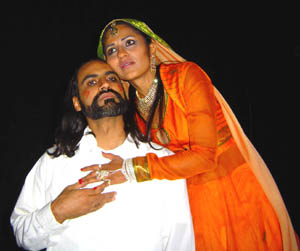Begum Sumroo Draws Curious
Crowds
By
Ali Hasan Cemendtaur
s
After drawing crowds
of intrigued people for two weeks, the play
‘Begum Sumroo, the Rebel Courtesan’ held its
last show on Sunday October 24 at the Artaud
Theater in San Francisco. The play was produced
by Theater Rasa Nova, a nascent group, in collaboration
with Ekta.

Ghulam Qadir and
Farzana |
‘Begum
Sumroo’ is a dramatization of the tumultuous
times of the latter half of the eighteenth century
witnessing the crumbling of the house of Timur
and the growing influence of the English in
India.
The events revolve
around the colorful life of Farzana, a prostitute
of Kashmiri descent, whose intrepidity and entrepreneurship
make her the wife of General Walter Reinhardt,
a young officer of East India Company, and later
make her rule the small kingdom of Sardhana
on her husband’s death.
Whereas no credit
has been given to the historical references
of the play I suspect Pratap Sharma, the playwright,
derived his information from ‘Begam Samru: Fading
Portrait in a Gilded Frame’ written by John
Lall and ‘Dark Legacy, the Fortunes of Begam
Samru’ a book by Shreeve Nicholas. In an obvious
marketing stunt Sharma has creatively changed
the name of the historical character from Begum
Samru to Begum Sumroo--the unsuspecting audience
believes the play is about an obscure Sindhi
warrior lady.
‘Begum Sumroo’ is
a carefully put together script. Pratap Sharma
takes a curious audience along as the play progresses
from one scene to another: the transition of
a German soldier of fortune to General Samru;
Farzana, Ghulam Qadir Rohilla’s favorite concubine,
moving on from a spy to a traitor to becoming
the wife of General Samru; Ghulam Qadir captured
by the army of Mughal emperor Shah Alam, and
castrated as a punishment for treason; General
dying and Begum Sumroo taking over the command
of General’s army; Ghulam Qadir’s usurpation
attempt with the help of Mansoor Ali, eunuch
in Shah Alam’s court; Ghulam Qadir taking revenge
by pulling out Shah Alam’s eyeballs; Begum Samru
attacking the army of Ghulam Qadir; capture
and execution of Ghulam Qadir; and Begum Sumroo’s
love affair with another young soldier, and
later confession before the priest.
Begum Sumroo has
a big cast with many actors from director Vidhu
Singh’s earlier productions. The lead roles
of Ghulam Qadir, Farzana, General Samru, Mansur
Ali, and Shah Alam are played by Saqib Mausoof,
Nidhi Singh, Axel Parker, Rakesh Modi, and Sonny
Harris respectively. Sukanya Mehra plays Zulekha
and Janaki Ranpura plays Gauri, friends of Farzana.
Raj Pakkala plays Inayatullah, an Indian military
officer. Karl Wieser plays two roles: that of
Benedict, a friend of Walter Reinhardt, and
of George Thomas, an Irish adventurer. Randall
Wright plays Saleur, a French mercenary. Nicholas
Hall plays Pauli a German mercenary. Grey Wold
plays Father Gregorio, an Italian priest. Cedric
Westphal plays Le Vassoult, a French mercenary,
later in the play a lover of Begum Sumroo.
As far as the enactment
of the play Begum Sumroo is concerned, this
correspondent saw some room for improvement.
Actors who aced their performances were Axel
Parker, Rann (playing the kathak dance teacher
of Farzana), Sonny Harris, Grey Wold, and Raj
Pakkala. This scribe couldn’t decide if at times
he had problem understanding the dialogs because
they were in English (this writer would have
preferred this very desi play enacted in Urdu/Hindi),
or because the rendering was at fault, or if
the acoustics of the Artaud Theater had to be
blamed.
One place where
the play did really well was in the costumes
of the actors. The European mercenaries were
dressed in eighteenth century attire, the Indians
donned clothes from the Mughal era, and the
Catholic priest wore an impressive robe.
The
two-week performance of ‘Begum Sumroo’ established
Vidhu Singh as a serious director. People tracking
her career see her taking bigger and bigger
challenges. Begum Sumroo was widely advertised
in the desi media and over desi mailing lists,
and attracted people from all over the Bay Area.

